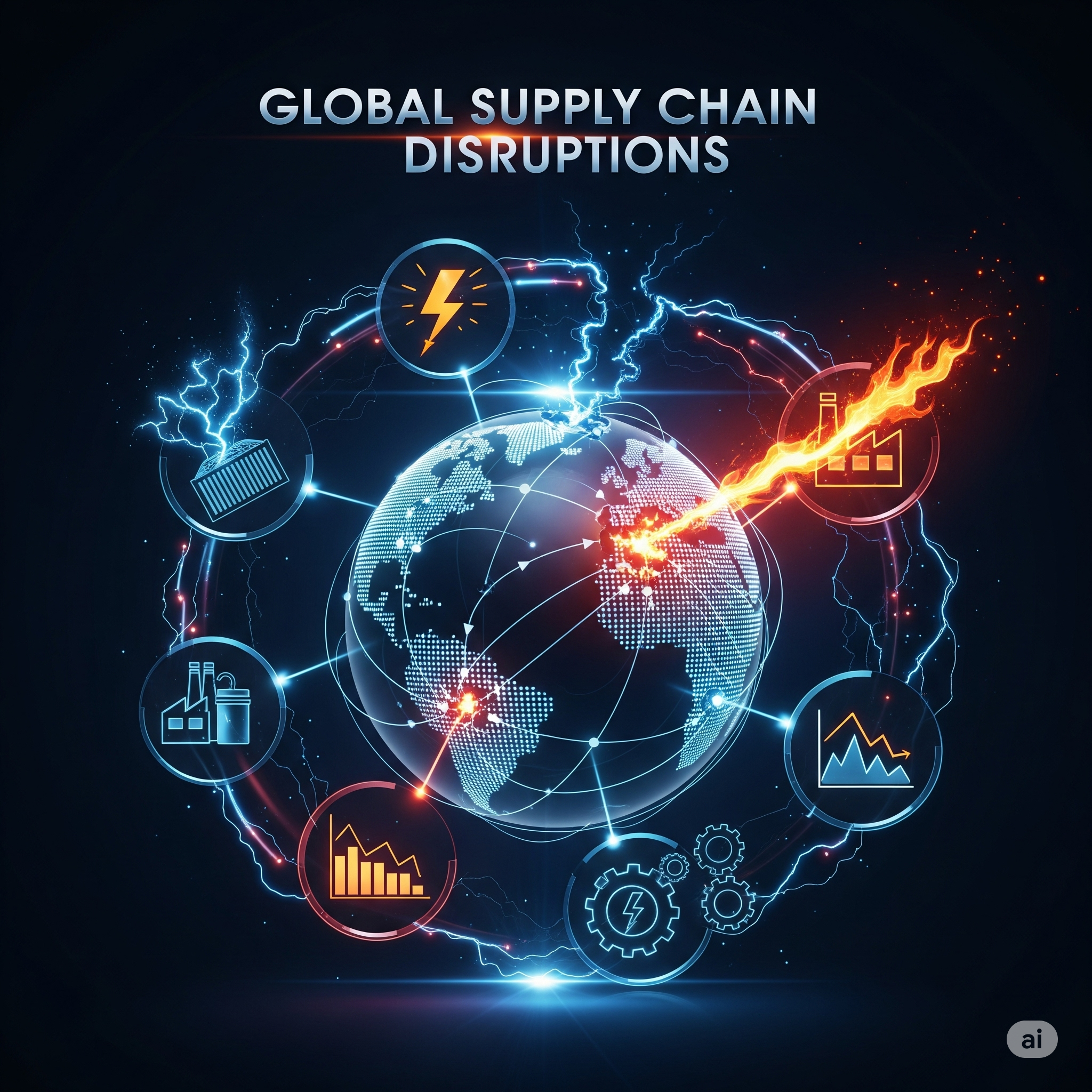Introduction
In today’s interconnected world, supply chains form the backbone of the global economy. A supply chain is the complex network of production, transportation, distribution, and consumption processes that ensure goods and services reach consumers across different countries. From raw material extraction to manufacturing, packaging, shipping, and retail, supply chains integrate multiple sectors and economies.
However, in recent years, the world has witnessed significant global supply chain disruptions—caused by events such as the COVID-19 pandemic, geopolitical conflicts, trade wars, natural disasters, climate change, and technological shifts. These disruptions have not only delayed production and raised costs but also reshaped the way businesses, governments, and consumers perceive globalization.
This article explores the nature of global supply chain disruptions, their causes, and their far-reaching economic consequences, while also analyzing possible solutions to build resilient and sustainable supply networks for the future.
Understanding Supply Chains in the Global Economy
Supply chains can be local, national, or global. A global supply chain involves cross-border movement of goods, services, and capital. Modern supply chains are highly complex and integrated because:
- Globalization of production – Different stages of production are carried out in different countries. For instance, smartphones are designed in the U.S., components are sourced from multiple Asian nations, and assembly is done in China.
- Just-in-time manufacturing – Many industries minimize inventory costs by relying on timely deliveries of parts, leaving little room for delays.
- Dependence on shipping and logistics – Over 80% of world trade by volume is carried by sea, making maritime routes critical.
Thus, any disruption at one stage of the chain can have a ripple effect across industries and economies.
Major Causes of Global Supply Chain Disruptions
1. COVID-19 Pandemic
The COVID-19 pandemic was one of the most significant disruptors in recent history. Lockdowns, travel restrictions, labor shortages, and factory shutdowns across countries halted production and caused delays in shipping. Container shortages, port congestions, and increased freight costs became global challenges.
2. Geopolitical Conflicts and Trade Wars
- Russia-Ukraine War (2022–present): This conflict disrupted energy supplies (oil and gas), food exports (wheat, sunflower oil), and raw materials (metals).
- US-China Trade War: Tariffs and restrictions on goods like semiconductors created bottlenecks and reshaped global sourcing strategies.
3. Natural Disasters and Climate Change
Earthquakes, hurricanes, floods, and wildfires disrupt infrastructure and supply routes. For example:
- The 2011 Japan earthquake and tsunami severely impacted the global electronics and automotive industries.
- Increasing climate-related events like heatwaves and rising sea levels threaten ports and transport infrastructure.
4. Shipping and Logistics Challenges
- Suez Canal Blockage (2021): The grounding of the Ever Given container ship blocked one of the busiest trade routes, delaying global shipments worth billions of dollars.
- Rising shipping costs and container shortages affect trade across continents.
5. Technological and Cyber Risks
Digital supply chains rely heavily on IT systems. Cyberattacks targeting logistics companies or critical infrastructure can paralyze operations. For example, ransomware attacks on shipping giant Maersk in 2017 caused massive delays.
6. Labor Shortages and Strikes
Truck driver shortages in Europe and the U.S., port worker strikes, and factory labor shortages during the pandemic disrupted movement of goods and services.
7. Policy and Regulatory Changes
Sudden changes in trade policies, sanctions, or export restrictions—like India’s wheat export ban in 2022—can destabilize global supply chains.
Economic Consequences of Supply Chain Disruptions
1. Inflation and Rising Prices
When supply is constrained and demand remains strong, prices surge. For example, semiconductor shortages pushed up car prices globally. Food and energy price hikes due to the Russia-Ukraine conflict also contributed to global inflation.
2. Slowing Global Trade and GDP Growth
Supply chain bottlenecks reduce the flow of goods, slowing international trade. The IMF and World Bank revised global GDP forecasts downward multiple times in 2020–2023 due to such disruptions.
3. Business Losses and Factory Shutdowns
Industries like automobiles, electronics, and pharmaceuticals faced losses due to lack of raw materials and components. For example, many car manufacturers halted production because of semiconductor shortages.
4. Unemployment and Income Inequality
Disruptions in industries lead to layoffs and income losses, particularly in export-dependent economies. Developing nations reliant on global supply chains (e.g., Bangladesh for textiles) were hit hard during the pandemic.
5. Impact on Small and Medium Enterprises (SMEs)
SMEs often lack the resources to manage supply chain shocks. They face higher costs and reduced competitiveness compared to multinational corporations.
6. Food and Energy Security Risks
Global food supply chains are highly vulnerable to disruptions. Shortages of fertilizers, grains, and cooking oil due to the Russia-Ukraine war threatened food security in Africa and Asia. Similarly, Europe faced an energy crisis due to reduced Russian gas supply.
7. Shift in Global Trade Patterns
Countries are rethinking overdependence on one region (especially China) for critical goods. This has led to:
- Nearshoring (shifting production closer to home markets).
- Friend-shoring (trading with politically aligned countries).
- Diversification of supply sources.
8. Impact on Financial Markets
Uncertainty in supply chains causes stock market volatility. Companies unable to deliver goods face reduced profits, affecting investor confidence.
9. Acceleration of Automation and Digitalization
To overcome labor shortages and enhance resilience, businesses are investing in robotics, AI, blockchain, and digital supply chain management systems.
Case Studies
Case Study 1: Semiconductor Shortages
The global chip shortage (2020–2022) disrupted industries from electronics to automotive. Delays in chip production caused revenue losses worth billions and forced companies like Ford and General Motors to cut vehicle output.
Case Study 2: Suez Canal Blockage
In March 2021, the Ever Given ship blocked the Suez Canal for six days. This single event delayed nearly 12% of global trade, impacting oil shipments and manufactured goods, and costing billions in trade losses.
Case Study 3: COVID-19 and Pharmaceutical Supply Chains
India and China dominate global pharmaceutical supply chains. During COVID-19, disruptions in raw material supply from China affected drug production worldwide, highlighting overdependence on specific countries.
Long-Term Implications of Supply Chain Disruptions
- De-globalization Trends: Countries may adopt protectionist policies to secure domestic supply.
- Reshaping Globalization: Instead of a single global hub, supply chains may become regionally diversified.
- National Security Concerns: Critical industries like defense, energy, and healthcare will prioritize domestic manufacturing.
- Sustainability and Green Supply Chains: Companies are focusing on reducing carbon footprints and ensuring environmental resilience.
- Resilient Infrastructure Investment: Governments and businesses are investing in ports, warehouses, and digital logistics solutions.
Strategies to Build Resilient Supply Chains
- Diversification of Suppliers: Avoiding dependence on a single country or supplier.
- Nearshoring and Friend-shoring: Shifting production closer to home or to trusted allies.
- Stockpiling and Strategic Reserves: Countries building reserves of essential goods like oil, food, and medical supplies.
- Digital Transformation: Using AI, blockchain, and IoT for real-time supply chain tracking and risk prediction.
- Investment in Local Manufacturing: Strengthening domestic production capacities in strategic sectors.
- Public-Private Collaboration: Governments and industries working together to create contingency plans.
- Sustainability Practices: Green logistics, renewable energy in supply chains, and circular economy models.
Conclusion
Global supply chain disruptions are not merely temporary inconveniences—they reshape the global economic order. The COVID-19 pandemic, geopolitical conflicts, natural disasters, and technological challenges have exposed vulnerabilities in interconnected supply networks. These disruptions have far-reaching economic consequences, from inflation and trade slowdowns to unemployment and food insecurity.
However, they also provide an opportunity for transformation. Building resilient, diversified, and sustainable supply chains is essential for future global economic stability. With investments in digital technologies, strategic reserves, and regional partnerships, the world can create supply chains that are more robust, adaptable, and environmentally sustainable.
The future of global trade and economic growth will depend largely on how effectively nations and businesses address these challenges and transform supply chains into engines of resilience and sustainability.




